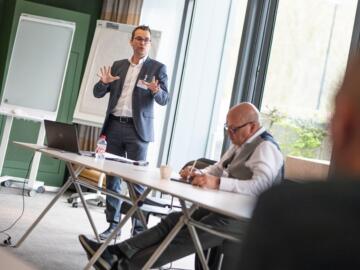Local authorities have to keep up with technological and digital developments in public space. By adopting innovative and digital technologies, our cities remain liveable and we make them smarter. A smart city or municipality uses technological innovations to increase the quality of life and comfort of the inhabitants and makes municipal processes and services more efficient with respect for economic, social and sustainable aspects.
By sensibly dealing with the opportunities that technology and digitalisation offer us, we can improve the information and communication in our cities so that we are ready for tomorrow. For example: Port of Antwerp uses Digital Twin technology to make a digital copy of the port to run simulations. This will give the port a better insight into the various traffic flows. Or Bonheiden that maps bicycle flows in bicycle registrations with IoT technology and adjusts the mobility policy accordingly.
Framework for innovation
A condition for achieving innovation within a (medium-sized) municipality, city or government organisation, is that innovation becomes a permanent part of your regular business operations. Government organisations must see innovation in the long term and get away from the short-term of legislation periods that is standard in politics. We have been or are currently guiding Aalter, Vilvoorde, the province of Flemish Brabant, Farys, Fluvius and S-LIM in shaping their policy vision and helping them with tangible policy strategies and short-term and long-term action plans.
Our framework consists of a number of steps in which we look for a long-term vision with the main question "who do we want to be?". Then we give this a strategic and tactical interpretation. The framework originated from our experiences with local authorities. It soon became clear that these organisations want to achieve results quickly, while at the same time are seeking a sustainable long-term solution. Because you have to take into account the specific situation of governmental organisations. They work and think in terms of legislatures. The ecosystem of a governmental organisation is also quite unique and consists of citizens, companies, service providers, knowledge institutions and peripheral municipalities.

Step 1: Current situation and future
During the first contacts and workshops with all relevant actors within the local government, we will look for the current situation (environmental analysis and policy objectives). During this first step, we already provide an overview of technologies and trends that could support future policy and indicate the opportunities and threats that current policy has.

Smart Cities
Become a smart city or municipality!
Step 2: Policy challenges
The elaboration of the first steps in the framework (current and future situation) gives us the opportunity to further investigate what the future needs of all stakeholders are and what identity the local government wants to radiate in the future. The correct reflection of the situation "AS-IS" and "TO-BE" gives us an overview of the policy challenges per policy area that the organisation can expect today, tomorrow and the day after tomorrow. It is important to consider that each policy area according to the Wheel of Cohen, namely society, quality of life, environment, governance, economy and mobility, is discussed.

Step 3: Orientation and prioritization
After that, we determine for each policy challenge which innovative solutions are possible. We use a number of predetermined criteria for this, such as added value and efficiency for the municipality, city and residents. Thanks to our experience, network and independent role in the market, we have a good overview of all available solutions for a Smart City. During the process, we look for the right solution for today and tomorrow. We determine at this stage which projects are important, which projects need a longer timeline and more advocates, and low hanging fruit.
Step 4: Action plan and dare to participate
Innovation is interdisciplinary and covers a variety of themes. It is therefore important to bring the right people to the table together. In consultation with relevant companies and or stakeholders, we will investigate which innovations are feasible in the short term and we will hold further discussions about this.
Question rounds and participation trajectories are possible intermediate steps that can clarify what these innovations can potentially yield for residents and other stakeholders. This way, you show what you are doing and trigger enthusiasts and interested parties to participate and, above all, support increases. And so we achieve our ultimate goal, which is to create support for change to create an innovative environment that is fully supported by the entire organisation and everyone involved.
Curious how you can become a Smart City too?
Or do you want more information on cities and municipalities of the future?
Get in touch!
Our experts in this domain

Astrid Bastiaens Innovation & Strategy Consultant

Filis Zumbultas Strategy & Innovation Consultant

Sven Geiregat Innovation & Strategy Consultant

Mobility in Flanders: the future starts now
How do we connect Flanders’ people and businesses in a smooth, safe, healthy and futureproof way? This is our key challenge and the starting point of a daring glimpse into tomorrow’s mobility.

Limburg explores the future
TomorrowLab helped Limburg to develop four possible and plausible future scenarios, which enabled the province’s stakeholders to make well-informed decisions.

Sought and found: communication of the future
Politicians often opt for a short-term strategy with quick wins to have a positive influence on voting behaviour. The Municipal Council of Aalter cannot be accused of that.
